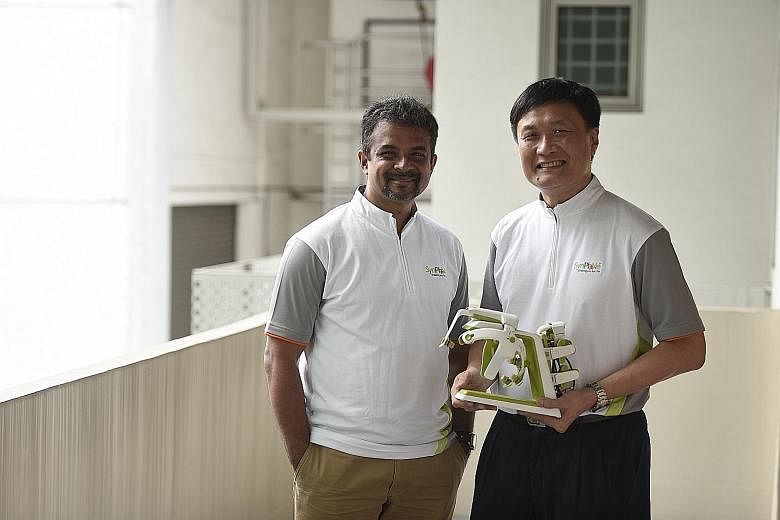Q How was SynPhNe born?
Dr Banerji: It started with me experimenting with rehab on myself after I underwent a brain-muscle injury in 1998 in India. I was involved in a serious car accident and smashed my hip. Doctors said I would never walk without an aid again. I was about 34 years old then, and I didn't have anything to lose from trying something new.
I was already practising yoga, taiji and some forms of martial arts then. So I experimented with some of those techniques and achieved remarkable results after a few months.
My health was such that I could not continue my previous work - an engineering business in India - so I became a therapist for five years because I saw that I could help people.
I met John in 2007, when I went to the Nanyang Technological University (NTU) in Singapore for my master's in biomedical engineering. He was already working in the field of robotics.
We started doing research to develop the system around 2007 or 2008. We did some initial studies at Tan Tock Seng Hospital (TTSH) with nine patients, and a follow-up trial after that in which we got very good results. We got an innovation grant from National Research Foundation (NRF) and Singapore-MIT Alliance for Research and Technology and later another grant from Spring Singapore.
We decided to form the company in 2013 - before that, we had been working out of the robotics lab at NTU. We coined the name SynPhNe, which stands for "synergy between physio and neuro".
In October last year, we did a demo with Harvard Medical School and it took it up for a pilot study.
Q How will SynPhNe help patients, therapists and hospitals?
Dr Heng: When we were working with TTSH we could see there was a real manpower crunch among the therapists. Each patient needed many hours of therapy a week and there were only so many therapists available.
We realised SynPhNe can help solve the manpower crunch by supplementing a patient's time with therapists with home rehabilitation.
However, because this is such a paradigm shift from the way traditional therapy is done, it took an enormous amount of effort to convince the establishment of this.
Our technology is based on taiji, martial arts and yoga principles.
We asked therapists to give us patients they thought had gone as far as they could with hospital treatment. Patient after patient after patient improved after just a few weeks. These were patients who had come out of three or four years of traditional therapy. We had them opening bottles, writing, even playing the guitar in some cases.
Dr Banerji: Another very entrenched mindset is associating treatment with a hospital or clinic. In 2013, the number of people with a permanent disability crossed one billion. In Singapore, we have more than 200,000 people who require daily therapy, but we barely have 400 therapists.
TTSH sees between 40 and 50 patients a day with a 30-member team. A similar team in India, where we did the trial, looks after 300 a day. In the United States, because the cost of one session is so high, dropout rates are also high once insurance support stops.
This problem exists everywhere.
This just seems to be a market going out of control and 60 per cent of the market is invisible because the patients have dropped out of healthcare entirely. They've accepted their condition, that it's the best that medical science and therapy can do for them.
Dr Heng: With the ageing population in Singapore, the Government wants more independent living. The family nucleus is already so small, with very little resources to devote to caregiving. The more we can get people back into the workforce, or even living independently, the quality of living will go up and we can free up resources.
Q How do you plan to make the device more widely available and which markets are you targeting?
Dr Banerji: We're looking at three markets to start - India, US, and Singapore.
We're going to the US early because it still leads the thought leadership. Once we get an okay from a large institute there, the acceptance in Asia will be faster and we can scale up more quickly.
But there's also the question of cost. People spend a lot now to support a stroke patient at home, for instance, buying hospital beds. We want to financially model our business such that we're not subsidising anyone, because that would not be sustainable.
We're looking at providing the customer options, depending on the type of market in each country - such as outright purchase, a rental model, monthly instalments or a micro finance model, to name a few.
We're also looking at delivering this via a franchise of training centres - the centres will be located close to patients and they can go there to learn how to use the device at home.
We've started building our first therapy centre very close to New Delhi in India, and that should roll out in the first quarter of next year.
We already have a location identified in Singapore for a similar first centre, but we can't disclose this yet. How soon we can roll it out here depends on us obtaining regulatory approval, which is still in the works.
Q Does the platform have other applications beyond treatment of stroke patients?
Dr Banerji: What's available today is the arm and head gear, to recover movement in arms. Development is under way for the lower limbs and eventually. we plan to look at the whole body.
In the longer term, we plan to develop new types of software for different conditions or forms of rehabilitation - for instance, besides stroke, we're also looking at hypertension, high blood pressure, and so on.
If we have many units distributed across different geographies, we can easily distribute new software by asking people to subscribe .
Also, what's great about this is everything is being monitored - the device collects data on the patient's progress, which therapists did not previously have access to.
In the past, patients had to go back to the therapist and it's all guesswork as to how they did at home, but here, it's all measured.
What we're trying to do in the Singapore entity is to create intellectual property. There are a lot of advantages to being located here as an IP-generating company. This IP and all the knowledge from the data will be the main value base for our business in the long term, not the device .
Dr Heng: There are many applications, not just in physiotherapy.
The system can address ageing, stress-related disorders, attention deficit hyperactivity disorder, other challenges of modern-day living.
We've developed a platform and we can do multiple things with it. We're starting off with rehabilitating stroke patients, but there is a whole range of possibilities.
Correction note: This story has been updated for clarity.


